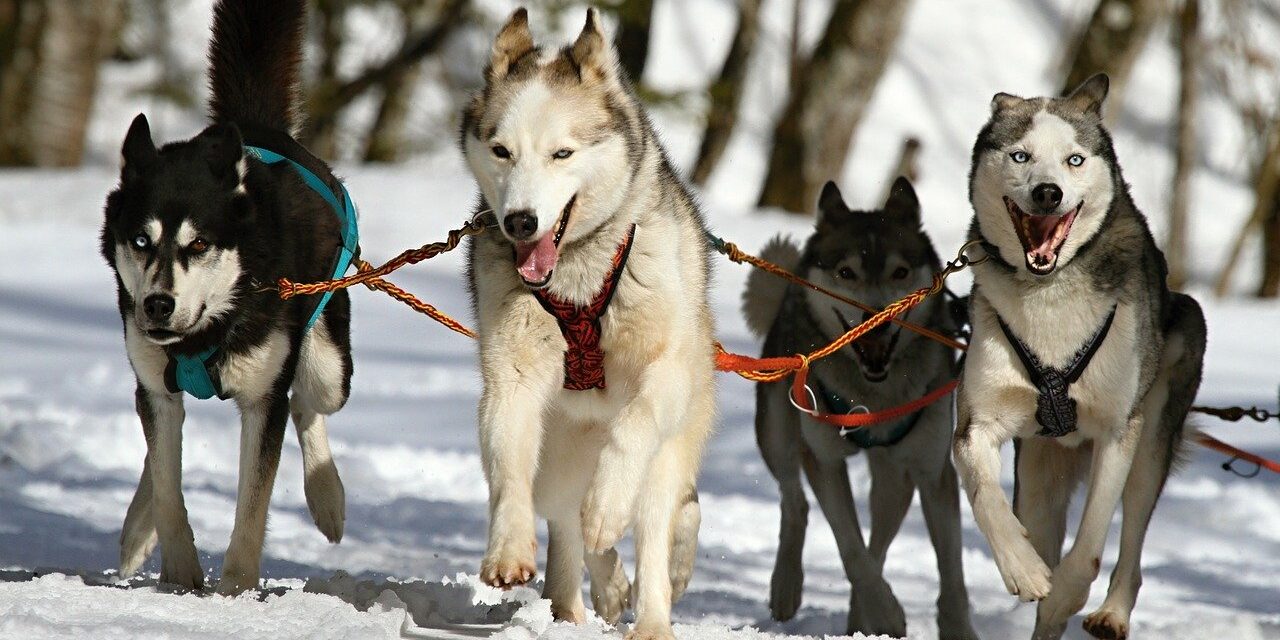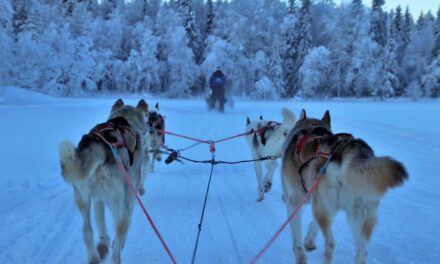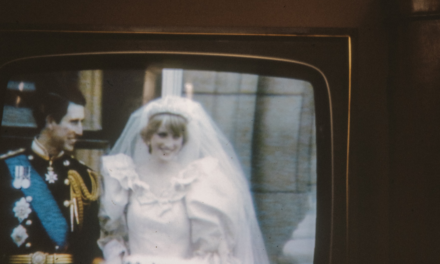Name: Ed and Tasha Stielstra
Kennel: Nature’s Kennel
Birthplace: Ed-Kalamazoo, MI :: Tasha-Grand Rapids, MI
Current Residence: McMillan, MI (Eastern Upper Peninsula)
Occupation: Mushers, Sled Dog Tour Operators
Introduction To Our Mushers
Ed and I have been involved in mushing together for about 10 years. After both graduating from Michigan State University, we worked in “the real world” for several years (Ed as a production supervisor and myself as a teacher) before deciding to pursue mushing on a full time basis. After living in Duluth, MN for several years, we decided to move our operation to Michigan’s Eastern Upper Peninsula. We now operate a distance racing kennel and a sled dog touring business.
The Background of Our Mushers
How did you get involved with the sport of dog sledding?
Ed helped out a friend from Ludington about 15 years ago and then branched off to start his own kennel 12 years ago. I married a great guy who had a couple cute puppies and a few adult dogs.
Could you tell us about your first mushing adventure?
I remember when Ed and I first started training together and we would double sled; Ed ran the first sled and I the second. I planted my face into many snowbanks as we went careening around corners. Ed always wanted to run large teams, the trails were never very snow packed, and the second sled is about as easy to steer as a toboggan. I guess I learned to crash really well.
Who have been your biggest supports during your mushing years?
Ed visited Martin Buser about 10 years ago with the intention of purchasing a couple of lead dogs. Martin asked Ed if he had ever tried training his own dogs. Ed’s reply was no. Martin told him to go home, try to train your own lead dogs, and then come back. Ed returned home, trained his then 2 year old dog Badger to run lead. Badger went on to lead four Iditarods. Ed never returned to Martin’s to buy a lead dog, and Badger retired this year at the age of 12. Thanks for the advice, Martin!
How long have you been addicted to mushing?
See above.
Maintaining A Kennel
How is your kennel setup?
The dogs are on a swivel post with a 7 ft. chain. Each dog can reach their neighbor to play and wrestle with. There are platforms (doggie decks) which hold 55 gallon plastic barrels. The dog bowls are attached to the houses. The dog houses are in two long rows so that we can run between them with the sled/quad and not have to turn the team around. It makes feeding and hooking up very efficient. (See photo)
How many lucky dogs currently enjoy your kennel?
119 kids, consisting of puppies, adults, and some free wandering old dogs.
What is the feeding routine for your dogs?
High performance dry food and beef.
What is your kennel philosophy?
We are coaches, the dogs are the team. A good coach remains calm and consistent regardless of the situation. A good team respects the coach and will give their all.
What is important to you when maintaining a kennel of working dogs?
All the dogs need dry straw through out the fall and winter. We remove the straw in the spring and summer. We also have our dogs close enough to each other so they can interact. We’ve found this to decrease aggression and increase sociability.
Working With the Dogs
What physical attributes do you try and produce in one of your average sled dogs?
We look for the average size to be 45-55 lbs. We strive to breed dogs who show no aggression, have no previous history of injuries, who are proven racers, who have smooth gaits, and who have a desire to run.
What breeds do you currently mush with?
Alaskan Huskies.
What is the demeanor like in all of your sled dogs?
We strive for mentally balanced dogs who are calm under stressful conditions, who lead with respect, and who can keep it together when the going gets tough.
The Magical World of Puppies
How do you house your puppies?
In whelping pens which have insulated houses on top of concrete block “basements” so the mothers can take the puppies into a cool area in the summer. Older puppies are in an extra large puppy pen where there is an obstacle course.
During the first months of a puppy’s life, what does their training consist of?
Once the puppies are old enough to walk, they go on walks twice a day following their mother or another reliable adult. We teach them to come whenever we call.
What do you look for in your breeding pair?
We breed dogs who have a proven race history, who have desirable social skills, and who we think are fun to work with.
Training: The Hard Part
What is your way of thinking when it comes to racing and training?
Be calm and consistent. We require all our guides and handlers to read Ceasar’s Way by Cesar Milan.
Could you describe your yearly training program?
We begin 4-wheeler training August 1st and continue with quads until the snow flies (about December 1st). Our teams are all on individual schedules; adults on a race training program, two year olds on an altered race program, and one year olds and retirees prepare run tours. The summer months are spent bonding with the dogs through free walks, trips to the lake, etc.
What tools are most important to you when training your sled dogs?
Patience, good handlers, time, organized equipment, patience, good rain gear, organized training log, and more patience.
What are your training goals each year?
To get each dog to perform to the best of it’s ability.
Racing: Oh Glorious Racing!
Do you race? If so, what races?
Yes. Iditarod, La Grande Odysse, UP 200, Beargrease.
What are your goals during the racing season?
To get our two year old and yearlings into as many races as possible so they see new trails, run with other teams, and experience stressful race starts. Our main team (dogs 3 years and older) is raced competitively.
Could you tell us about your first race?
Ed talked me into my first race at a MUSH event in Baldwin, MI. I raced in the three-dog class and thought my team was going way too fast!
How do you decide which dogs make the race team?
They weed themselves out based on training miles and physical ability. All of our main team must run lead.
If you could, what are your racing strengths and weaknesses?
Strengths: Ed, he’s highly organized (he loves Microsoft Excel), he operates well under stress and sleep deprivation. Ed makes the Excel spread sheets for her!
How do you decide which races you will be entering during the racing season?
We enter races that benefit our Iditarod team. We also enter races close to home which benefit our younger dogs.
What Does the Future Hold?
What do you hope to accomplish with the dog sledding sport?
To educate the public about dog sledding and to make the world a better place for dogs.
What changes do you hope dog sledding makes in the near future?
Finding ways to get more spectators and sponsors involved through technology (i.e. following a dog race in real time via the internet) and media coverage. There is a huge Iditarod following here in the Lower 48 but very few newspapers or television stations regularly cover the race.
To the beginning musher, what advice would you give?
Find a musher to work with that shares your ideals in regards to animal treatment, mushing style, and race goals. Learn to train your own dogs.
If mushers were to do something to perpetuate the dog sledding sport, what would that be?
Learn more about the psychology of dogs.
Anything else for the dog sledding community to hear?
Take the time to develop a relationship and tight bond with your dogs. The dogs will repay you in ways you have never imagined.





